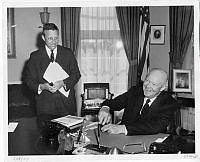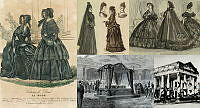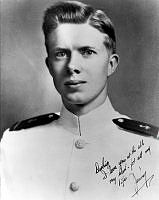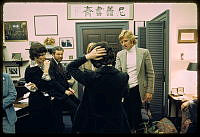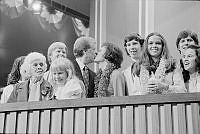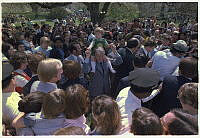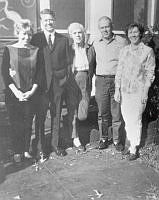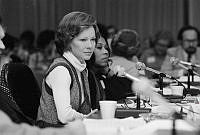Rubenstein Center Scholarship
Indiana and the White House
The White House is often referred to as the “people’s house.” Indeed, many people from across the United States have influenced the White House in a variety of ways. From elder statesmen to young innovators, the state of Indiana can proudly claim numerous connections with the White House – both with the physical building and with those who have occupied it.
Indiana claims two Hoosier presidents – William Henry Harrison and his grandson, Benjamin Harrison. William Henry Harrison’s Indiana roots actually preceded its 1816 statehood. After resigning from the United States Army in 1798, Harrison became Secretary of the Northwest Territory, serving as its first representative to Congress. During his tenure, he helped construct boundaries for the Northwest and Indiana Territories and became the latter’s first governor. Upon his nomination for the presidency by the Whig Party in 1840, Harrison, an avid nationalist, vowed to balance his policies by being attentive to the American people. With his impressive victory over the incumbent President Martin Van Buren, Harrison became the first chief executive with a deep Indiana association to occupy the Executive Mansion.1
While William Henry Harrison’s association with Indiana was more in the capacity of a soldier and long-distant statesman, Benjamin Harrison’s relationship with the Hoosier state traversed a more intimate path. Major General Lewis “Lew” Wallace delivered a eulogy for his good friend and former president Benjamin Harrison in 1901:
“To my mind one of the most remarkable points in Benjamin Harrison’s connection with the people of Indiana is that much as he talked of them, and to them, and for them, not one word could be traced to his utterance which the shrewdest opponent could torture into disrespect of them. Sir, he loved them, and they know it; wherefore it is no exaggeration to say that tonight Indiana in its entirety is mourning.”

This portrait of William Henry Harrison was painted in 1835 by James Reid Lambdin. Harrison, a retired army general, defeated Martin Van Buren in the presidential election of 1840.
White House Historical Association (White House Collection)Harrison also had a profound impact on the White House. He approved the installation of electricity in 1891, and “incandescents” in the White House afterward, despite his and his wife Caroline’s skepticism that they would work properly.2 Their concerns were understandable, since Thomas Edison’s incandescent light bulb had been invented only a decade prior to its first appearance in the White House.3
In addition to two presidents, Indiana produced six vice presidents: Schuyler Colfax (New Carlyle); Thomas Hendricks (Jefferson County); Charles W. Fairbanks (Indianapolis); Thomas R. Marshall (North Manchester); Dan Quayle (Indianapolis/Huntington); and Mike Pence (Columbus).The half-dozen Hoosier vice presidents are the second most by any state, trailing only New York (11).4
General Lewis Wallace had political relationships with many presidential administrations and visited the White House on a variety of occasions. Perhaps the most notable for the Brookville native was when President Abraham Lincoln appointed Wallace as Commander of the 8th Army Corps at Baltimore. The post culminated in Wallace’s successful defense of Washington, D.C. from invading Confederate forces under Jubal Early in 1864. President Rutherford B. Hayes appointed Wallace Governor of the New Mexico Territory in 1878, and President James Garfield appointed him United States Minister to the Ottoman Empire in 1881. Wallace also befriended President William McKinley and President Theodore Roosevelt later in his life.5 General Wallace’s legacy continues to be honored today. In 2008, First Lady Laura Bush honored the General Lew Wallace Study and Museum in Crawfordsville, Indiana with the National Medal for Museum and Library Service.6

This portrait of President Benjamin Harrison was painted by artist Eastman Johnson in 1895. Harrison was the grandson of President William Henry Harrison.
White House Historical Association (White House Collection)Besides the Harrisons and General Lewis Wallace, another major Indiana connection with the White House comes from architect Eric Gugler.7 When President Franklin D. Roosevelt wanted to expand the executive offices of the White House and relocate the Oval Office to its present location in 1934, he commissioned Gugler to lead the project.8 The architect completely rebuilt the West Wing by expanding the second story, excavating a larger basement, and moving the Oval Office to the southeast corner. Despite occasional renovations and alterations, the West Wing has not seen major, structural renovations since Gugler’s work. Most notably for Hoosiers is Gugler’s role in the expansion of Wabash College’s campus in 1953-1954. Gugler designed various buildings at the institution, including multiple dormitories, the main student center, and several academic halls.9

Vice President Thomas R. Marshall, a native of North Manchester, Indiana, sits behind his office desk in Washington, D.C. Marshall served as vice president during the Woodrow Wilson administration (1913-1921).
Library of CongressMany notable Hoosiers have entertained at the White House. James Whitcomb Riley – a native of Greenfield, Indiana – attended numerous White House functions, at least one of which was at the direct request of President Benjamin Harrison.10 On April 1, 1892, Riley recited his poems in the East Room of the White House in front of President and First Lady Caroline Harrison, as well has their invited guests. Mary Lord Dimmick, aide to and niece of Mrs. Harrison, noted that the occasion was a “charming and handsome affair.”11 Through his “dialect poetry,” Riley’s work conveyed the beauty and rustic nature of the Indiana countryside.12 The renowned poet also received recognition from later presidents, such as President Woodrow Wilson who, upon hearing of Riley’s passing in 1916, noted Riley as “a man who imparted joyful pleasure and a thoughtful view of many things that other men would have missed.” 13,14 Riley spent the final 23 years of his life settled in his famous Lockerbie Street home in Indianapolis where he penned many poems for children.15 His poetic legacy – especially for his appeal to young readers16 – is cemented in the namesake of Riley Children’s Hospital in Indianapolis.17
A native of Vincennes, Indiana, entertainer Red Skelton performed at the White House for many birthday and Independence Day celebrations. Skelton regaled presidents ranging from Franklin D. Roosevelt to Bill Clinton. While attending one White House luncheon during the Roosevelt administration, Skelton is said to have grasped the president by the arm and told him, “Be careful what you drink, Mr. President. I got rolled in a place like this once.” From that point forward, Skelton was one of Roosevelt’s favorites.18 Years later, President Richard Nixon is said to have thanked the entertainer for his eagerness to perform during troubled times when the nation needed a good laugh.19

General Lewis "Lew" Wallace, a native of Brookville, Indiana, sits for his Civil War-era portrait.
Library of CongressComedy and poetry were not the only facets of recreation at the White House in which Hoosiers were involved. Bill O’Brien, former executive chef at Elkhart General Hospital in Elkhart, Indiana, spent one week as White House Chef during the Clinton administration in February 1998. In an article in the South Bend Tribune, O’Brien recounts the thrill of preparing a 240-guest State Dinner for British Prime Minister Tony Blair. O’Brien even gave insight on how the White House kitchen operates during State Dinners, recounting how chefs worked seamlessly to produce incredible culinary fare.20
Historians have called Madam C.J. Walker one of the first self-made millionaires in the history of the United States. Madam Walker achieved this feat as a driven, African-American woman in early 20th century Indianapolis, where she started the cosmetics business Walker Manufacturing Company.21 Her business was very successful, but it was her desire for social justice and activism that made her famous. On September 1, 1917, Madam Walker led a group of Harlem leaders to present a petition at the White House calling for strong legislation against lynching.22 In fact, her activism to abolish lynching extended far beyond the White House and throughout the world.23

This photograph, taken by Theodor Horydczak in the fall of 1935, shows the West Wing after President Franklin Roosevelt ordered a major renovation of the executive offices. Architect Eric Gugler expanded the second story, excavated and constructed a basement level of additional office space, and moved the Oval Office to the southeast corner where it remains today.
Library of CongressThe White House has even been decorated with holiday wreaths and trees from the Hoosier State. In December 1957, the Garden Club of Indiana presented First Lady Mamie Eisenhower with a Christmas wreath made from delicate Indiana flowers and plants.24 For President Jimmy Carter’s final White House Christmas, an 18-foot Douglas fir that hailed from Bristol, Indiana was displayed in the Blue Room.25 More recently, Shari Koenes, a resident of Prince’s Lake, Indiana helped deck the halls of the Executive Mansion in 2011 and 2012, which passed light-hearted inspection by First Lady Michelle Obama.26
Contemporary Hoosiers have also contributed to the White House in ways that have impacted the nation as a whole. In 2016, two teams of middle school Indiana students participated in the White House Science Fair. One team developed an “app” to assist dyslexic students with math problems, while the other team created a way to evenly heat food in a microwave by eliminating what they called the “hot spot waste.”27 At the White House Water Summit in March of 2016, a cooperative project between students from the University of Notre Dame and Indiana University was specifically highlighted. The collegial Hoosier institutions’ research focused on watershed-scale conservation to reduce nutrient runoffs from farms. Not only did the cooperative project promote one of Indiana’s largest industries at the White House, but the venture also illustrated the many Indiana institutions that are working for the greater good of the country.

Indiana poet James Whitcomb Riley, ca. 1895.
Library of CongressThe state of Indiana has famously produced politicians and ambassadors; however, hidden Hoosier gems are plentiful. From entertainers to social justice activists to scientists, Hoosiers of all ages have influenced the White House in a variety of ways. As Indiana progresses into its third century of statehood, one can certainly expect the Hoosier state to continue shaping White House history.

A postage stamp honoring entrepreneur and civil rights activist Madam C.J. Walker.
The Indiana Historical Society













